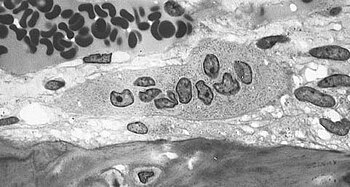Bone health
This article may require cleanup to meet Wikipedia's quality standards. The specific problem is: This article has been primarily written by one author. While it seems to be good quality, it has clearly gone unnoticed by most people and is in need of another set of eyes. The original author was clearly unfamiliar with some Wikipedia conventions. (June 2016) |
The human skeletal system is a complex organ in constant equilibrium with the rest of the body. In addition to support and structure of the body, bone is the major reservoir for many minerals and compounds essential for maintaining a healthy pH balance.[1] The deterioration of the body with age renders the elderly particularly susceptible to and affected by poor bone health. Illnesses like osteoporosis, characterized by weakening of the bone's structural matrix, increases the risk of hip-fractures and other life-changing secondary symptoms. In 2010, over 258,000 people aged 65 and older were admitted to the hospital for hip fractures.[2] Incidence of hip fractures is expected to rise by 12% in America, with a projected 289,000 admissions in the year 2030.[3] Other sources estimate up to 1.5 million Americans will have an osteoporotic-related fracture each year.[4] The cost of treating these people is also enormous, in 1991 Medicare spent an estimated $2.9 billion for treatment and out-patient care of hip fractures, this number can only be expected to rise.[5]
Amino acid metabolism
When more sulfur containing

In healthy adults, bone is undergoing constant repair and renewal. New bone is deposited by osteoblast cells and resorbed or destroyed by osteoclast cells. This addition and subtraction of bone usually yields no net change in the overall mass of the skeleton, but the turnover process can be significantly affected by pH.[1]
Bone mineral density
Bone mineral density (BMD) is a measure commonly used to quantify bone health. A lower BMD value indicates an increased risk of an osteoporosis or a fracture.[9] There is a large range of factors influencing BMD. Protein consumption has shown to be beneficial for bone density by providing amino acid substrates necessary for bone matrix formation. It is also thought that blood concentration of the bone formation stimulant, Insulin-like Growth Factor-I (IGF-I), is increased from high protein consumption and parathyroid hormone (PTH), a bone resorption stimulant, is decreased.[10] Although protein has shown to be beneficial for increasing bone mass, or bone mineral density, there is no significant association between protein intake and fracture incidence.[11] In other words, a low BMD can be predictive of osteoporosis and increased fracture risk, but a higher BMD does not necessarily mean better bone health. High BMD is also correlated with other health issues.[12] For example, a higher BMD has also been associated with increased risk of breast cancer.[13]
Acid–base homeostasis

Most metabolic processes have a specific and narrow range of pH where operation is possible, multiple regulatory systems are in place to maintain
Homocysteine
Osteoclast cells

Osteoblast cells

Osteoblast are responsible for the mineralization and construction of bone matrix. They are responsible for the formation or production of bone tissue.[18] The origin of the osteoblasts and osteoclasts is from primitive precursor cells found in bone marrow.[18] Like osteoclast cells, osteoblast cell activity is directly related to extracellular pH mirroring of osteoclast activity. At pH 7.4, where osteoclasts are inactive, osteoblast are at peak activity. Likewise, at pH 6.9 osteoblast activity is non-existent.[16] The hormone estrogen is also important for osteoblast regulation. In postmenopausal women estrogen levels are decreased which has negative effects on bone remodeling. Homocysteine further exacerbates this problem by reducing estrogen receptor α mRNA transcription. Thus reducing any beneficial effect that estrogen plays on bone remodeling.[17]
Bone balance
Acidosis inhibits bone
Diet
There is no one food or nutrient capable of providing adequate bone health on its own. Instead, a balanced diet sufficient in fruits and vegetables for their vitamins, minerals, and alkalinizing substrates is thought to be most beneficial. High protein diets supply larger amounts of amino acids that could be degraded to acidic compounds. Protein consumption above the Recommended Dietary Allowance is also known to be beneficial to calcium utilization. Overall it is understood that high-protein diets have a net benefit for bone health because changes in IGF-I and PTH concentrations outweigh the negative effects of metabolic acid production.
See also
- Copper in health
References
- ^ PMID 9614169.
- ^ "National Hospital Discharge Survey (NHDS)". National Center for Health Statistics. Archived from the original on 30 November 2013. Retrieved 24 November 2013.
- PMID 23632827.
- PMID 22332082.
- PMID 8927007.
- ^ PMID 11124760.
- S2CID 81933816.
- ^ PMID 7797810.
- PMID 9302892.
- ^ S2CID 1332501.
- PMID 19864406.
- PMID 23445662.
- PMID 9663400.
- ^ PMID 14506899.
- PMID 23551968.
- ^ PMID 18203913.
- ^ PMID 23449525.
- ^ ISBN 978-1-4160-3401-8.
